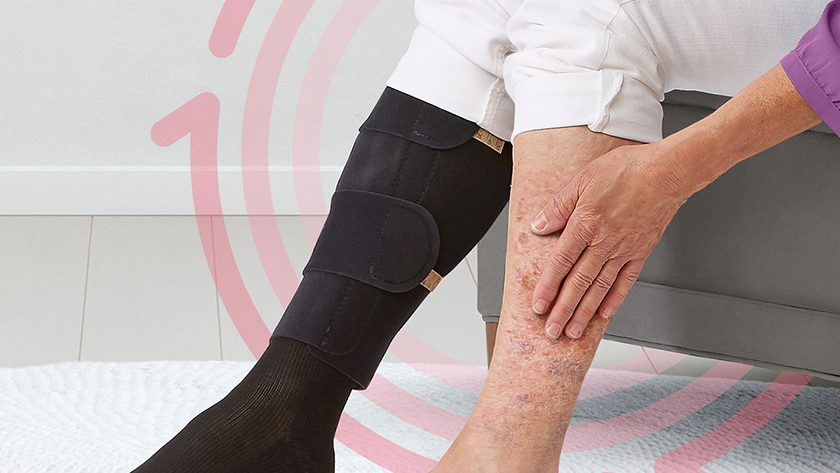Venous leg ulcers: 4 ways to help improve patient compliance and quality of life
Treat chronic venous insufficiency with the right compression therapy and education.

Chronic venous insufficiency (CVI) affects about 2.5 million people in the United States.¹ It happens when the one-way valve of the veins in the leg fails to circulate blood properly, causing venous stasis, or the pooling of blood.
About 20 percent of people who have CVI develop venous leg ulcers¹ (VLUs). A venous leg ulcer can lead to open, draining wounds and can negatively affect a person’s quality of life.
2.5 million
people in the U.S. with CVI1
20%
of people with CVI develop a VLU1
It’s important to know how to best care for your patients’ venous leg ulcers so you can improve outcomes and quality of life.
What causes VLUs?
When blood isn’t getting properly pumped to the heart, it stagnates and collects in venous blood vessels, causing the vein to stretch and weaken. Eventually the swollen blood vessels leak fluid and proteins, decreasing the flow of oxygen and nutrients to the tissue, leading to tissue death and venous leg ulcers. The drainage itself is caustic to skin, which is why venous stasis can cause skin breakdown. Patients can experience itchy skin, discoloration in the ankle-to-calf area, swelling, and often throbbing and achiness.
Here are 4 strategies to help:
1 | Select the right treatment
Compression is key to healing venous ulcers and supporting healthy circulation in the legs.
Innovative compression wraps and pull-on socks come in a wide range of styles: long-stretch and short-stretch, two-, three- and four-layer, Velcro, foam impregnated with zinc or calamine, and pneumatic compression devices.
It can be confusing, so here are some general guidelines to knowing which one to choose for your patient:
- Only use garments and wraps specifically designed for compression. For example, never use a 4-inch-long stretch elastic bandage for compression. These bandages may slip out of place and constrict areas of the leg and cause harm.
- Long-stretch elastic should only be used to hold a dressing in place.
- Avoid thromboembolic disease (TED) stockings. These are elastic stockings meant to prevent thrombophlebitis. They are not designed for managing edema associated with chronic venous insufficiency. In fact, the band at the top of a TED stocking is constrictive and can injure the skin.
- If your patient has a wound with drainage, choose an absorbent product. For example, a four-layer compression product provides both absorption and compression.
- If a patient will be caring for themselves at home, a customizable compression garment might make it easier.

2 | Apply compression properly
It’s important to apply compression correctly so the compression can do its job. Always follow manufacturer’s instructions and also consider these techniques:
- Start by cleaning and drying the patient’s legs and feet with a gentle cleanser. This will help prevent topical infection or cellulitis.
- Moisturize intact skin with a soothing cream. If there’s drainage, use a moisture barrier. If you’re worried about dermatitis or a fungal infection, it’s best to consult a physician, as the patient may need topical medications.
- Apply the compression garment or wrap from the base of the toes all the way up to just below the knee; this protects bony prominences and helps absorb exudate. Most manufacturers suggest a 50 percent overlap.
- Change the compression depending on drainage and the patient’s compliance. If there’s no open wound, the dressing can be changed once or twice a week. With an open, draining wound, change it two to three times a week to manage drainage.
- At each dressing change, assess and treat the wound.
3 | Encourage patient compliance
People with chronic venous insufficiency might want a quick fix, but to improve their quality of life, their disease requires their participation on an ongoing basis.
When patients don’t comply with treatment, it’s important to understand why.
When talking with your patients about adhering to their treatment plans, keep these common issues in mind:
- Complaints about inability to pay for compression stockings.
- The patient is frail or obese and may have a hard time with dressing changes.
- Lack of mobility or living alone can mean a patient is physically unable to apply compression or change wound dressings by themselves.
- Compression is uncomfortable to wear, particularly in hot, humid weather.
- Wraps or garments are difficult to put on and a patient may simply give up.
- If a patient sees improvement, they might think they can stop compression.
4 | Help educate patients on lifestyle adjustments
It’s important to talk to your patients about compression therapy and other actions they can take to help manage their disease.
Collaborate with physical therapists and occupational therapists who can suggest ways for patients to keep active and help teach patients and family caregivers the best ways to apply compression.
When devising a care plan, work with your patients to come up with reasonable goals based on their lifestyle choices.
In general, remind patients that they should:
- Elevate their legs a little every day.
- Keep active by walking or doing calf pumps or toe-up exercises.
- Inspect their feet and legs during dressing changes and report any changes.
- Avoid sitting or standing for extended periods of time.
- If they smoke, encourage quitting because nicotine has direct adverse effects on oxygenation.
- Maintain a healthy weight and limit salt intake.
Key takeaway
When it comes to managing venous stasis disease, it’s important to understand how to select and apply the right compression. This lifelong disease can be a burden for patients, so put yourself in their shoes, understand why they might not comply with treatment plans and help educate and encourage them to participate in their care.
Explore more content on venous stasis disease:
Venous stasis calls for compression: Use this chart to choose the right solution for your patients
Watch the webinar—Compression: why, when and how
Venous stasis management: Empower patients to care for themselves
Patient compliance: Start the conversation
Build a strong team to achieve better results
Take a class: The Skin and Risk Factors for Nursing Assistants
References:
- Eberhardt, R. T., & Raffetto, J. D. (2014). Chronic Venous Insufficiency. Circulation, 130(4), 333–346. Available at https://doi.org/10.1161/circulationaha.113.006898
